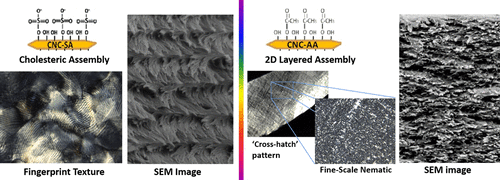当前位置:
X-MOL 学术
›
Biomacromolecules
›
论文详情
Our official English website, www.x-mol.net, welcomes your feedback! (Note: you will need to create a separate account there.)
Phase Behavior of Acetylated Cellulose Nanocrystals and Origins of the Cross-Hatch Birefringent Texture
Biomacromolecules ( IF 6.2 ) Pub Date : 2018-06-26 00:00:00 , DOI: 10.1021/acs.biomac.8b00746 Mingzhe Jiang 1 , Matthew F. McMillan 1 , Virginia Davis 2 , Christopher L Kitchens 1
Biomacromolecules ( IF 6.2 ) Pub Date : 2018-06-26 00:00:00 , DOI: 10.1021/acs.biomac.8b00746 Mingzhe Jiang 1 , Matthew F. McMillan 1 , Virginia Davis 2 , Christopher L Kitchens 1
Affiliation

|
Cellulose nanocrystals hydrolyzed by hydrochloric acid and esterified by acetic acid produce acetylated cellulose nanocrystals (CNC-AA) with acetyl ester surface functional groups. While much attention has been paid to understanding the phase behavior (liquid crystal) of aqueous dispersions of sulfonated nanocrystals, relatively few studies have focused on CNC-AA dispersions. CNC-AA dispersions exhibit multiple phase regimes and markedly different phase behavior due to their lower surface charge. At concentrations above 5.0 × 10–4%vol, a decrease in the apparent diffusion coefficient indicates the onset of interparticle interactions and a transition from the dilute regime. From 0.003 to 0.31%vol, biphasic behavior is observed, consisting of a birefringent lower phase and disordered or isotropic upper phase. Small-angle neutron scattering was used to measure the growth of fractal structures with increasing concentration and indicates a two-dimensional assembly with short-range order in a plate-like assembled geometry. Above 0.31%vol, the dispersion transitions exhibit a cross-hatch birefringent texture, which is believed to exist as a fine-scale nematic that possesses frozen-in flow shear behavior, consistent with a glassy phase. This cross-hatch pattern is maintained in dried films, where atomic force microscopy and scanning electron microscopy reveal a layered sheet-like structure. Imaging also indicates that the basic unit of CNC-AA microstructure in the film consists of 0.5–1.5 μm scale aligned nanorod domains, which agrees with neutron scattering and the dimensions of each individual “hatch” in the birefringent texture observed by cross-polarized microscopy. The assembly of the nanorods into this layered structure and the fine-scale nematic birefringent cross-hatch texture is of significant fundamental interest, particularly since it differs greatly from cellulose nanocrystals with other surface chemistry and offers potential opportunities in other applications owing to the unique assembly.
中文翻译:

乙酰化纤维素纳米晶体的相行为和交叉影线双折射纹理的起源
盐酸水解并被乙酸酯化的纤维素纳米晶体会生成具有乙酰基酯表面官能团的乙酰化纤维素纳米晶体(CNC-AA)。尽管已经对理解磺化纳米晶体的水分散体的相行为(液晶)进行了很多关注,但相对较少的研究集中在CNC-AA分散体上。由于其较低的表面电荷,CNC-AA分散体表现出多相态和明显不同的相行为。浓度高于5.0×10 –4%vol,表观扩散系数的降低表明粒子间相互作用的开始和从稀薄状态的转变。从0.003%至0.31%vol,观察到双相行为,由双折射下部相和无序或各向同性上部相组成。小角度中子散射被用来测量分形结构随着浓度的增加而增长,并表明在板状组装几何结构中具有短程有序的二维组装。高于0.31%vol,色散转变呈现出交叉影线双折射结构,据信以细尺度的向列形式存在,其具有冻结的流动剪切行为,与玻璃相一致。这种交叉影线图案在干膜中得以维持,其中原子力显微镜和扫描电子显微镜显示出层状的片状结构。成像还表明,薄膜中CNC-AA微观结构的基本单位由0.5–1.5μm的比例排列的纳米棒域组成,这与中子散射和通过交叉偏振显微镜观察到的双折射织构中每个“舱口”的尺寸一致。将纳米棒组装成这种层状结构和精细尺度的向列双折射交叉影线纹理具有重大的基本意义,特别是因为它与具有其他表面化学性质的纤维素纳米晶体有很大不同,并且由于独特的组装而在其他应用中提供了潜在的机会。5微米尺度的对齐纳米棒域,这与中子散射和通过交叉偏振显微镜观察到的双折射织构中每个单个“舱口”的尺寸一致。将纳米棒组装成这种层状结构和精细尺度的向列双折射交叉影线纹理具有重大的基本意义,特别是因为它与具有其他表面化学性质的纤维素纳米晶体有很大不同,并且由于独特的组装而在其他应用中提供了潜在的机会。5微米尺度的对齐纳米棒域,与中子散射和通过交叉偏振显微镜观察到的双折射织构中每个单个“舱口”的尺寸一致。将纳米棒组装成这种层状结构和精细尺度的向列双折射交叉影线纹理具有重大的基本意义,特别是因为它与具有其他表面化学性质的纤维素纳米晶体有很大不同,并且由于独特的组装而在其他应用中提供了潜在的机会。
更新日期:2018-06-26
中文翻译:

乙酰化纤维素纳米晶体的相行为和交叉影线双折射纹理的起源
盐酸水解并被乙酸酯化的纤维素纳米晶体会生成具有乙酰基酯表面官能团的乙酰化纤维素纳米晶体(CNC-AA)。尽管已经对理解磺化纳米晶体的水分散体的相行为(液晶)进行了很多关注,但相对较少的研究集中在CNC-AA分散体上。由于其较低的表面电荷,CNC-AA分散体表现出多相态和明显不同的相行为。浓度高于5.0×10 –4%vol,表观扩散系数的降低表明粒子间相互作用的开始和从稀薄状态的转变。从0.003%至0.31%vol,观察到双相行为,由双折射下部相和无序或各向同性上部相组成。小角度中子散射被用来测量分形结构随着浓度的增加而增长,并表明在板状组装几何结构中具有短程有序的二维组装。高于0.31%vol,色散转变呈现出交叉影线双折射结构,据信以细尺度的向列形式存在,其具有冻结的流动剪切行为,与玻璃相一致。这种交叉影线图案在干膜中得以维持,其中原子力显微镜和扫描电子显微镜显示出层状的片状结构。成像还表明,薄膜中CNC-AA微观结构的基本单位由0.5–1.5μm的比例排列的纳米棒域组成,这与中子散射和通过交叉偏振显微镜观察到的双折射织构中每个“舱口”的尺寸一致。将纳米棒组装成这种层状结构和精细尺度的向列双折射交叉影线纹理具有重大的基本意义,特别是因为它与具有其他表面化学性质的纤维素纳米晶体有很大不同,并且由于独特的组装而在其他应用中提供了潜在的机会。5微米尺度的对齐纳米棒域,这与中子散射和通过交叉偏振显微镜观察到的双折射织构中每个单个“舱口”的尺寸一致。将纳米棒组装成这种层状结构和精细尺度的向列双折射交叉影线纹理具有重大的基本意义,特别是因为它与具有其他表面化学性质的纤维素纳米晶体有很大不同,并且由于独特的组装而在其他应用中提供了潜在的机会。5微米尺度的对齐纳米棒域,与中子散射和通过交叉偏振显微镜观察到的双折射织构中每个单个“舱口”的尺寸一致。将纳米棒组装成这种层状结构和精细尺度的向列双折射交叉影线纹理具有重大的基本意义,特别是因为它与具有其他表面化学性质的纤维素纳米晶体有很大不同,并且由于独特的组装而在其他应用中提供了潜在的机会。



























 京公网安备 11010802027423号
京公网安备 11010802027423号